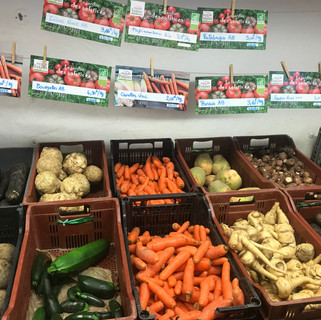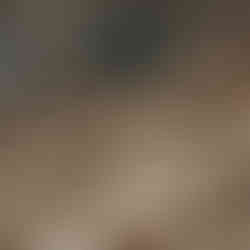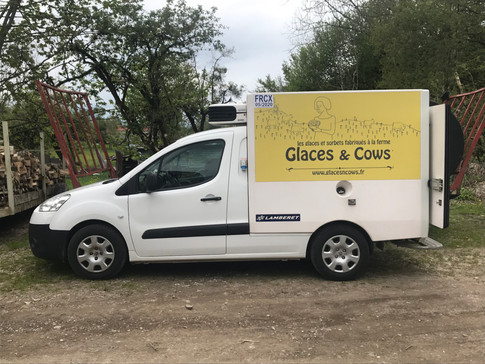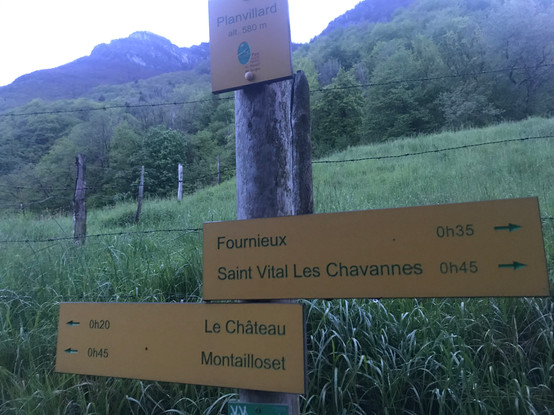Raising Goats & Making Cheese in Savoie
- Chris and Leah

- Jun 11, 2019
- 10 min read
Updated: Jan 3, 2020

The idea behind visiting farms in Europe during our sabbatical this year was to gain information and experience on raising animals and producing animal products that could be shared with future students. Chevrerie Planvillard-a goat dairy operation in the French Alps near Albertville-was just the sort of place we were hoping to find. The small scale of the farm is appropriate for people interested in starting a livestock business. The value-added products they produce show the importance of maximizing your income potential as a small farm, and they demonstrate creativity and wisdom in their diverse strategies to direct market their products.
Virginie and Patrice, our hosts and farm mentors, bought the property and started the farm 20 years ago. The farm is located in Savoie, a French Department with a deep connection to local products and regional recipes. There are many cheeses traditionally produced in the area and the demand is high, so they figured cheese was a good business to get in to. Twenty years later, they have a business that is well adapted to the size of the property, the available labor, and the demand of their markets. Patrice manages the livestock production and Virginie is the cheesemaker. They both work full-time on the farm, which is their only income. They usually have 1 or 2 volunteers March-November, plus help from their family.
This is a goat dairy. They recommend working with goats because they are relatively easy to manage. They are smaller and need less pasture land and barn space than cows, are less likely to destroy fences, cost less to purchase, produce less manure to muck out, and produce milk that some believe to be more digestible.
Currently they are milking 50 females (does). They chose the ‘Alpine’ breed for its adaptation to the local climate, milk fat content, and ease of birthing. On average, the does produce about 2 liters of milk per day, though this varies with the time of year, quality of forage/feed, and overall health. Milking takes place twice a day, at 7am and again at 4pm. The milking parlor has 12 stanchions and 3 vacuum lines with 2 udder cups each. It takes about an hour to milk the whole herd, with assistance from their border collies.
The does have kids in late winter and some of the female kids are kept for herd replacement. The males are sold to other people and farms for meat production. They keep their own male goats (bucks) to save money compared to the high cost of artificial insemination. We were surprised to learn that they like to eat orange peels!
The goats have access to pasture from about Mid-May to Mid-October. The rest of the year they are fed hay that is produced on-site. We helped make the first hay of the season which was bailed with a small bailer and then loaded by hand onto the hay wagon and into the barn for winter. The does are bred with the buck each year.
At milking, the milk is about 90F. The morning milk is immediately transformed in the cheese room (fromagerie), while the afternoon milk is cooled (38F) and used the next day. They make cheese every day, since their storage capacity is limited as the entire operation takes place under one roof- their living quarters in the front part of the house while the goats live in the basement below and the hay barn, milking parlor, and fromagerie are all towards the back end of the house. A very cool, very traditional farmhouse setup. The short 'commute' up the stairs to the fromagerie made starting at 6:45am a little easier on us.
The milk is not pasteurized, and all the cheese is ‘raw’. While it can have some regulatory challenges, they believe the taste of the raw milk is better. The average French consumer is discerning and seems to care more about the taste and quality of the cheese than they do about any risks from raw milk.
The Products
Whatever the style of cheese being made, there are some important factors that require attention. First, sanitation of the cheesemaking area is imperative to avoid any microorganisms contaminating the cheese. In addition, temperature of the milk, number of times the milk is heated, type of bacteria added, quantity of rennet, and maturation time are all important factors in getting a consistent result. After the curds and whey are separated, it is time to call in Little Miss Muffet. Curd size also matters, the smaller the curd the more water can be removed resulting in a ‘harder’, more firm texture.
The basic process is to heat the milk to the proper temperature (except the lactic cheeses which were produced at room temp), add bacteria and rennet, stir and wait. Then, the curd is cut and the whey is drained. Next, the cheese goes into molds of whatever form is desired. Later, usually the next day, we turned the cheese to create a shape that looked consistent throughout and so the water would drain uniformly.
We learned to produce 10 different types of cheese from start to finish- starting with receiving the fresh milk from the milking parlour (happening in the next room over) and finishing with packaging for the store. Each cheese has its own unique combination of the factors above to achieve a specific style. The photos below illustrate most of the cheeses we made. In France, cheesemaking is serious business and many cheeses have protected regional appellations, like wine grapes. For example, ‘Camembert’ is protected and thus can only be produced in that region. Instead, we made a camembert style cheese (but with goat milk), but it has to be marketed by a different name. The same was true for what Virginie called ‘Chamosseran’, because ‘Mobier’ is regionally protected.
Lactic varieties (rond, brique, crottin)
Fromage Blanc
La Tomme de Savoie
Bleu
Feta
Sérac
Le Petit Roc (Chevrerie Planvillard specialty cheese covered with ash)
Raclette
Carre Fleuri (Camembert style) / Chamosseran (Mobier style)
After turning the cheeses, some had herbs or ash added before going into the Affinage, an aging/drying fridge set to specific temp and humidity levels. Inside the Affinage, the humidity was greater at the top and the back of the fridge, so turning and rotating the cheeses was a daily necessity to keep them consistent. From here, some cheeses were sold directly after a brief aging period of 2-7 days. Other cheeses, like the Tomme, Raclette, and Mobier were moved to the cave built in the basement for more aging. The feta was also aged further, submersed in buckets filled with a saltwater solution.
The Markets
The Store - The quantity of cheese that was made in the fromagerie each day was really impressive. To our surprise, there wasn’t a schedule of which cheeses were made each day. Instead, they are making cheese for such a specific market that they can tailor the production, on a daily basis, to what is needed. Their primary outlet is a coop-like store about 15 minutes from the house that Chevrerie Planvillard is part owner, along with nine other owner/farmer families. It’s called “The Flavors of Our Farms” (Saveurs de Nos Fermes), and exclusively sells products produced in Savoie. There are 34 other farms that sell through the business at various times of year.
Each day at least one of the owner/farmers works at the store, along with some paid employees. They have meats, dairy (divided into cow/goat/sheep), produce, eggs, wine, bread, and processed products. When a product runs out or is low in the store, they call the fromagerie and request more of it. So, an afternoon call that the lactic cheese (or whatever else) is out, leads to producing more the next morning and replacing it the day after that. This keeps inventory aligned with demand, but also leaves a gap of a couple days where that product is sometimes not available at the store.
The store is busy; so busy they are expanding to a larger location in November of this year. Buying local products is part of the culture in Savoie, especially products that support their local diet which is heavy on cheese, wine, and bread. This makes their store an especially good way to reach buyers for their products. For each Euro of product sold through the store, the farmer/owners keep about 85 cents. The rest goes to support the store, pay wages, advertise, etc. For the non-farmer/owners selling through the store, they keep about 75 cents. These are both pretty high numbers compared to selling into most grocery stores offering a middle ground between farmer’s markets and traditional wholesale markets.

AMAP - Their second market is through AMAP (Association pour le Maintien d'une Agriculture Paysanne or association for maintaining small-scale family farming), a subscription program basically similar to CSA (Community Supported Agriculture) in the U.S. However, unlike most CSA’s, multiple farms (rather than a single farm) deliver to the drop-off site on the same day at the same time. This gives members the chance to get local produce, cheese, bread, meat and more each week, from a single location, and support multiple producers in the process. For the Chevrerie, it involves a weekly or biweekly delivery of a chosen value of cheese (8, 10, or 12 Euros) plus add-ons like yogurt and milk desserts if desired. The menu varies based on which cheeses are fresh and being aged or produced that week. Some of the drop sites had refrigeration and others didn’t, complicating things a bit for the milk, cheese, and produce deliveries.
For both of these markets, the usual volume of product being delivered was small enough that it fit into the family’s Subaru Outback. No need for another truck or van for the business, just drop off the cheese and then pick the kids up in the same car. As farmers they seemed very conscious of decisions like this and really looked for ways to avoid making high cost purchases when another way was available to them.

Direct Sales from Fromagerie - The last way they sell cheese is directly from their home. They allow people to just knock on the door of the farmhouse and buy some cheese. In our time there, it seemed like about 2 or 3 people per week did this, usually only for small amounts of cheese. They viewed this as a way to introduce people to the farm; families could come look at the goats or the rabbits and buy a little cheese. To us though, it seemed to interrupt the flow of the workday significantly in exchange for just a few Euros. The culture of chatting, catching-up with the neighbors, allowing people to come to the door during work and sharing a glass of wine any time of day also complicates getting work done.
The Partner Farms
Thanks to the cool arrangement of the 10 farmer/owners in their store, we were able to visit a couple of the other partners. First, we wound our way up a steep mountain to get to En Plein Air, a producer of mixed breed pork. They raise pigs year-round and entirely outside in forest and pasture. They buy 8 groups of 30 piglets (one group per month March through October) and raise them to market weight (about 6 months). The pigs are taken to the nearest abattoir for slaughter and then the rest of the transformation is done at the farm. They make nearly every imaginable pork product; all the cuts, cured meats, sausages, pate, etc.
The products are sold through the store, other supermarkets, and through their on-farm butcher shop. It was surprising to us to see customers driving to a rural location to buy their pork products, but the quality of the meat and diversity of the products, as well as the lower price compared to in the store made it worth the trip.
Next, we visited ‘Glaces and Cows’ a cow dairy that makes many flavors of ice cream right on the farm. They milk 40 ‘Montbelliard’ cows twice a day and turn 10% of the milk into ice cream that is marketed through the store, on a cool ice cream bicycle in summer, direct from the farm, and through other local shops. The husband/wife team handles the cows and marketing, while two paid employees actually make the ice cream. The rest of the milk is sold to their neighbor monks at the Abbey de Tamié. There the monks only produce Tamié de Savoie, a cheese made using the same process since the 12th Century.
This farm was a good example of a willingness to be creative and diversify their business. When Nicolas took over the farm from his father in 2009 they switched from just selling bulk milk, to adding value with the ice cream. It sounds like business is going well and the ice cream demand is increasingly annually. They also have two AirBnBs on the farm as an alternative income stream. We stayed in the old chapel for a night on the property which they converted into a cozy space with vaulted ceilings and a wood stove. It even had an old church pew. In the evening we got to choose a pint of ice cream from the on-site supply and Hillary brought us a bottle of fresh milk for our coffee in the morning!
The Rest
When we weren’t working on the farm, we were able to take advantage of the rich nature and culture of the French Alps. The concept of private property is nothing like what we are used to at home. The public is allowed to walk most trails through other people’s property. The farm property was located inside a Natural Park and some of the trails that go deeper into the mountains connected right through the farm property. The trails in the area were all clearly signed with locations and estimated hiking times. We took advantage of the chance to hike down the mountain to a small lake, up the mountain to waterfalls, and over the mountains to see the surrounding area. We also took a weekend trip to see Mount Blanc, the highest peak in Europe, about an hour drive away.
Our other cultural experience was primarily eating and drinking. No matter the meal or how long it has been since the last one, there is the need for bread and cheese. One night we treated ourselves to a nice meal at Les Trappeurs, a widely-known restaurant serving all traditional Savoyard dishes in a crafty Savoie cabin-style atmosphere. We ordered Reblochonade served with an entire wheel of Reblochon, plus charcuterie, potatoes, and salad. And of course, local wine and vacherin for dessert, which is made by layering meringue, berry sorbet, ice cream and whipped cream.
Our last night at the farm, our hosts made a Raclette dinner for us, where all sorts of meat, veggies, bread, etc. are covered in melty cheese, like a piecemeal fondue (another dish from Savoie, not Switzerland, they’ll tell you). After all that, the family still went for more bread and extra cheese from the fridge, just for good measure. Seriously, we think they averaged 4-6oz. of cheese per person, per meal.

Wine too, of course, is part of the culture. It is considered bad form to decline an offer of a drink, even if it’s 11am and you are at work. Once, on a lunch time walk through the nearest village, we were treated by their neighbor Jean, to a tasting of the many wines he made himself from local grapes. After every sip, when we thought we could escape, more wines, with more stories about their origins, more pickles, and more homemade didot (Savoie local sausage) appeared on the counter. Luckily, many of the local whites and roses are light and refreshing but we still walked home a little woozy.
The ‘French Miracle’-that they don’t all die at 40 from extreme consumption of cheese, cream, alcohol, and cigarettes-is as mystifying and frustrating as ever. Nevertheless, it definitely seems real. They enjoy what seems to be a rich diet without terrible consequences. Maybe it’s genetics, or their lifestyle is more active, or the ingredients aren’t all synthetic and GMO. Whatever the reasons behind it, we can at least say that the result is that most of the business close in the afternoon, usually 12-2 or so. This lets everybody do lots of eating and drinking and then take a nap before they have to go back to work for a couple more hours.
We sure will miss Savoie culture and eating the French way. Goodbye for now Alps!


















































































































































































Looks like a great farm!